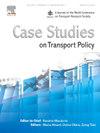A feedback-guided analysis of environmental, health and socio-economic factors affecting drivers’ willingness to shift to e-jeepneys
IF 2.4
Q3 TRANSPORTATION
引用次数: 0
Abstract
The Jeepney Modernization Program involves the replacement of traditional jeepneys with more efficient alternatives, including modern enclosed electric vehicles, alongside operational improvements to the public transportation system. This study aims to assess the environmental, health and socio-economic factors impacting drivers’ willingness to shift to e-jeepneys. Feedback-Guided Analysis was used as a framework for designing an interdisciplinary approach towards understanding the decision-making paradigms of drivers plying a specific route in Quezon City, Metro Manila. Measurements of drivers’ exposure to PM2.5 and associated health parameters were complemented by key informant interviews delving into income, expenses, valuation of benefits and decision-making paradigms. A stock-and-flow model integrated the data to quantify costs and benefits of conventional vs. electric jeepney drivers. Results show that conventional jeepney drivers are unlikely to shift to electric vehicles if the projected take-home pay does not support daily expenses, despite the additional benefits of the modernized system including lower exposure to PM2.5. Of the daily wage scenarios tested, only the highest at Php 900/day met the threshold for drivers’ needs. The socio-economic feedback in terms of take-home pay dominated over the health and environmental feedback on worldviews. Understanding these stakeholder contexts and priorities is a crucial step towards building trust, co-developing interventions, and overcoming barriers to policy implementation.
求助全文
约1分钟内获得全文
求助全文

 求助内容:
求助内容: 应助结果提醒方式:
应助结果提醒方式:


